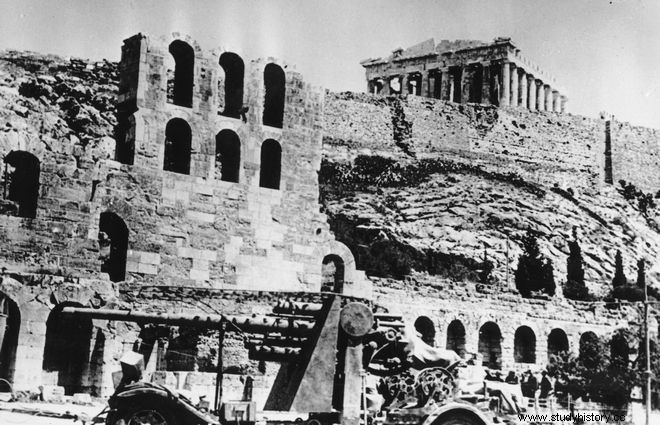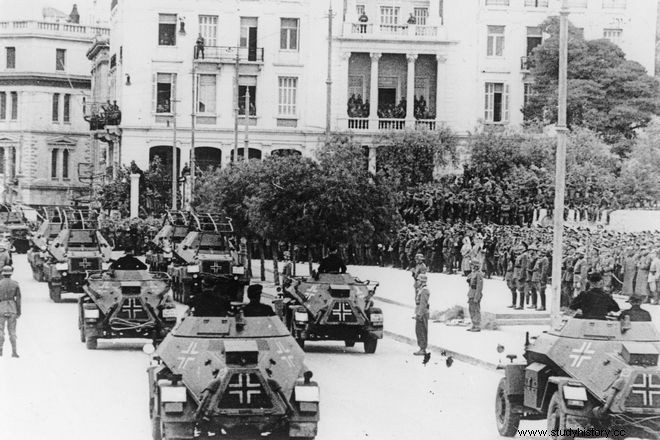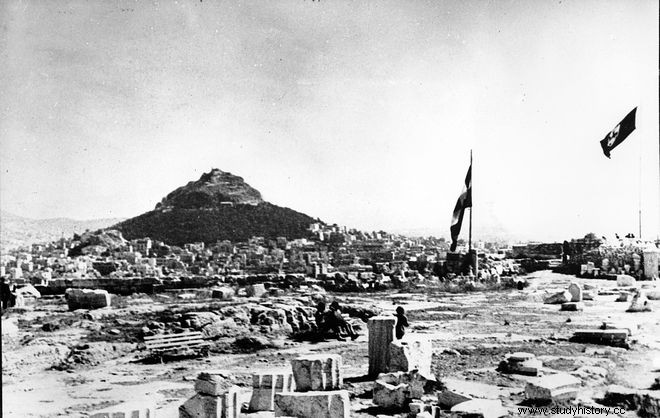On this day, on April 27, 1941, German troops entered Athens, marking the beginning of the Occupation period. At 08.00 on Sunday, April 27, 1941, motorcyclists and armored vehicles of the 2nd Armored Division led by Second Lieutenant Fritz Dirflig entered Athens from the northern suburbs.
At that time the Athens radio station was giving its last free communique:
In a cafe in Ampelokipi, the four men who surrendered the city of Athens were waiting for the invaders.
It was the guard of Athens, Lieutenant General Chr. Kavrakos, the prefect of Attikovoiotia K. Pezopoulos and the mayors of Athens and Piraeus Ambrosios Plytas and Mich. Manouskos.
The coffee shop in Ampelokipis was called "Lux" and was located at the intersection of Alexandras and Kifisias avenues, opposite the then mansion of Thon.

Greek officials declared that Athens was an unfortified city that had no intention of resisting. The German lieutenant colonel Von Scheiben essentially appointed the two mayors political administrators of Athens and Piraeus, while he made Lt. General Kavrakos a prisoner of war and responsible for any hostile acts.
The German troops are marching in the capital, with the "blocked houses", as the last radio message of the "still free Athens" said a few hours before.

As sansimera writes, the attack of Nazi Germany against our country took place at 5:15 in the morning on April 6, 1941 in the fortresses of Thrace and Eastern Macedonia, 45 minutes before the scheduled time, according to the German communication that had been served earlier to Prime Minister Alexandros Koryzis from the German ambassador in Athens, Prince Erbach.

Delivering the ultimatum, Erbach emphasized to Koryzis that the war was not directed against Greece, but against England, which had rushed to our country's aid with 62,000 men and a large air force. Koryzis said the second NO, this time to the white Nazi provocation. The German attack on Greece is a continuation of the Greco-Italian war, which began on October 28, 1940 with the Italian attack on the Greek-Albanian border.
The German offensive was code-named Marita and the order for its planning had been given by Hitler on December 13, 1940. The German dictator's aim was to help Mussolini's ally who was besieged by the Greeks in Albania and to secure the south in view of his impending attack on Russia (Operation Barbarossa). The Marita plan concerned not only Greece, but also Yugoslavia, the only Balkan countries, along with Turkey, that had not allied with the Axis.
The two-front struggle against Yugoslavia and Greece was undertaken by the German 12th Army under Marshal Wilhelm List, who had 680,000 men, 1,200 tanks and 700 planes at his disposal. Our country lined up 70,000 men in the forts of the Greek-Bulgarian border, led by Major General Konstantinos Bakopoulos, as the bulk of the Greek army was fighting the Italians in Albania. The English forces controlled the Tempo - Vermio axis, but the center of the front was weak and Thessaloniki an unfortified city.
The German offensive took place on the Greco-Bulgarian border front along the so-called Metaxa Line in Eastern Macedonia and the isolated forts of Echinus and Nymphaea in Thrace. At the same time, German aircraft bombarded Piraeus and the coasts up to the Salamis Naval Station, causing human casualties and enormous damage.
The so-called Metaxas Line is an ambitious fortification project, modeled after the Mazino Line, which was built on the initiative of the dictator Ioannis Metaxas, as a shield to prevent the Bulgarian danger. Great admiration and surprise had been caused to the German raiders by the hidden exits, unparalleled in any other fortification, the relatively low cost and the short construction period. If one takes into account that the Germans did not manage to locate the hatches of the forts before the start of the operations and that the Bulgarians knew nothing, the technical concealment and variation, the excellent quality of concrete, the lack of specialist of fortification armament and the perfect adaptation of the armament of the expeditionary army.
The defenders of the Forts (Nymphaea, Echinos, Lise, Istibei, Perithori, Rupel, Pyramidoidoid, Palouriones, etc.) strongly defended themselves for three days against the successive attacks of the superior German forces. They relented only when the German armored divisions, after the sudden collapse of the southern Yugoslav front, entered Skopje and from the Axios valley crossed the Greco-Yugoslav border on April 8, bypassing the Metaxa Line. At midnight of the same day, the German troops entered Thessaloniki and occupied the city.
The defenders of the Metaxa Line, now surrounded, were ordered by Commander-in-Chief Papagos to capitulate (April 9). Their heroism was recognized even by their opponents, with displays of admiration and tributes to the captured Greek fighters. Greek losses across the Eastern Macedonian and Thrace front amounted to approximately 1,000 dead and wounded. The corresponding German losses amounted to 555 dead, 2,134 wounded and 170 missing, a number corresponding to half of their total losses during Operation Marita, which demonstrates the extent of the Greek resistance.
During the following days, the German advance to the South was rapid, with the collapse of the Albanian front as well. By April 30, the entire mainland of Greece had been occupied and the country was under triple occupation:German, Italian and Bulgarian.
